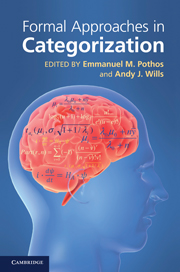Book contents
- Frontmatter
- Contents
- List of figures
- List of tables
- List of contributors
- 1 Introduction
- 2 The generalized context model: an exemplar model of classification
- 3 Prototype models of categorization: basic formulation, predictions, and limitations
- 4 COVIS
- 5 Semantics without categorization
- 6 Models of attentional learning
- 7 An elemental model of associative learning and memory
- 8 Nonparametric Bayesian models of categorization
- 9 The simplicity model of unsupervised categorization
- 10 Adaptive clustering models of categorization
- 11 Cobweb Models of Categorization and Probabilistic Concept Formation
- 12 The knowledge and resonance (KRES) model of category learning
- 13 The contribution (and drawbacks) of models to the study of concepts
- 14 Formal models of categorization: insights from cognitive neuroscience
- 15 Comments on models and categorization theories: the razor's edge
- Index
- References
4 - COVIS
Published online by Cambridge University Press: 05 June 2012
- Frontmatter
- Contents
- List of figures
- List of tables
- List of contributors
- 1 Introduction
- 2 The generalized context model: an exemplar model of classification
- 3 Prototype models of categorization: basic formulation, predictions, and limitations
- 4 COVIS
- 5 Semantics without categorization
- 6 Models of attentional learning
- 7 An elemental model of associative learning and memory
- 8 Nonparametric Bayesian models of categorization
- 9 The simplicity model of unsupervised categorization
- 10 Adaptive clustering models of categorization
- 11 Cobweb Models of Categorization and Probabilistic Concept Formation
- 12 The knowledge and resonance (KRES) model of category learning
- 13 The contribution (and drawbacks) of models to the study of concepts
- 14 Formal models of categorization: insights from cognitive neuroscience
- 15 Comments on models and categorization theories: the razor's edge
- Index
- References
Summary
Summary
The COVIS model of category learning assumes separate rule-based and procedural-learning categorization systems that compete for access to response production. The rule-based system selects and tests simple verbalizable hypotheses about category membership. The procedural-learning system gradually associates categorization responses with regions of perceptual space via reinforcement learning.
Description and motivation of COVIS
Despite the obvious importance of categorization to survival, and the varied nature of category-learning problems facing every animal, research on category learning has been narrowly focused (e.g., Markman & Ross, 2003). For example, the majority of category-learning studies have focused on situations in which two categories are relevant, the motor response is fixed, the nature and timing of feedback is constant (or ignored), and the only task facing the participant is the relevant categorization problem.
One reason for this narrow focus is that until recently, the goal of most categorization research has been to test predictions from purely cognitive models that assume a single category-learning system. In typical applications, the predictions of two competing single-system models were pitted against each other and simple goodness-of-fit was used to select a winner (Maddox & Ashby, 1993; McKinley & Nosofsky, 1995; Smith & Minda, 1998). During the past decade, however, two developments have begun to alter this landscape.
First, there are now many results suggesting that human categorization is mediated by multiple category-learning systems (Ashby & O'Brien, 2005; Ashby et al., 1998; Erickson & Kruschke, 1998; Love, Medin, & Gureckis, 2004; Reber et al., 2003).
Information
- Type
- Chapter
- Information
- Formal Approaches in Categorization , pp. 65 - 87Publisher: Cambridge University PressPrint publication year: 2011
References
Accessibility standard: Unknown
Why this information is here
This section outlines the accessibility features of this content - including support for screen readers, full keyboard navigation and high-contrast display options. This may not be relevant for you.Accessibility Information
- 35
- Cited by
